Posts Tagged by lish dorset
We The People Opportunity Farm and Plum Market Kitchen at The Henry Ford

Melvin Parson Gardening during the Entrepreneurship Interview, April 5, 2019 / THF295401
Our culinary team at The Henry Ford is continuously inspired by the stories we tell from our collections and the modern-day changemakers we have the privilege to work with. We’re also always looking for partners whose goals mesh with The Henry Ford’s goals for our food programming. Executive Chef David McGregor of The Henry Ford notes those include “understanding the connection that we have with the food we consume and passing this knowledge down to future generations to ensure a sustainable food system,” as well as “taking the time to understand the seasonality of the food grown in your region and building relationships with local farmers and artisans to create menus that reflect that availability as the seasons change.”
Last year the team created a series of recipes inspired by the work of George Washington Carver; this fall we worked with local farmer and social entrepreneur Melvin Parson, utilizing the products from his farm at The Henry Ford in Plum Market Kitchen. Parson is no stranger to The Henry Ford. As the founder of We The People Opportunity Farm, he was the Spring 2019 Entrepreneur in Residence at The Henry Ford, funded by the William Davidson Foundation Initiative for Entrepreneurship.
Learn more about Parson and his vision for change:
- How Melvin Parson Created an Urban Farming Initiative
- Melvin Parson: Market Gardener and Social Entrepreneur
- Innovation Journey with Melvin Parson
- Agriculture Pioneer Melvin Parson
We worked with Parson and his farm this fall to provide locally sourced ingredients in our restaurants, like those found in our Heirloom Tomato Salad with White Wine Vinaigrette. Enjoy it during a visit to Plum Market Kitchen, and then try making it on your own at home.
Heirloom Tomato Salad with White Wine Vinaigrette (serves many)
Ingredients: Tomato Prep
- 15 heirloom tomatoes
- 2 yellow onions, julienned thin
- 1 cup white wine vinaigrette
- 1 cup basil chiffonade
- 1 tbsp salt
- 1 tsp black pepper
Ingredients: Vinaigrette
- 2 cups olive oil
- 1 cup white wine vinegar
- 6 garlic cloves, minced
- 1 tbsp fresh parsley, chopped
- ½ tsp dried basil
- 1 tsp kosher salt
- ½ black pepper
METHOD: Salad
- Cut tomatoes into 1” chunks and place in a colander for a few minutes to drain excess moisture.
- Place tomatoes in a large bowl with other dry ingredients.
- Fold in Dressing for service, being careful to keep the tomato pieces intact.
METHOD: Vinaigrette
- Add all ingredients except oil and blend until smooth
- Slowly add oil while blending until everything is incorporated.
Lish Dorset is former Marketing Manager, Non-Admission Products, at The Henry Ford.
by Lish Dorset, farms and farming, entrepreneurship, recipes, restaurants, food
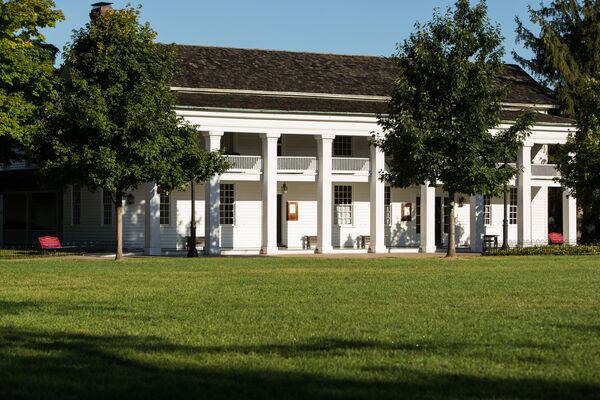
Photo by KMS Photography
When it comes to dining experiences, Eagle Tavern in Greenfield Village is one of a kind. The stagecoach tavern was built in 1831 in Clinton, Michigan. Calvin Wood and his wife Harriet operated it from 1849 to 1854, offering food, drink, and accommodations to the locals and those who came through the town. In 1927, Henry Ford purchased the tavern and brought it to Greenfield Village as the Clinton Inn, where it first served as a cafeteria for Edison Institute students and then for visitors. In April 1982, Eagle Tavern officially opened as the restaurant we know today. Forty years later, Eagle Tavern continues to delight members and guests with mid-1800s food and drink.
As we celebrate the beginning of the 2022 Greenfield Village season, Sous Chef Kasey Faraj shares three of his favorite Eagle Tavern recipes for you to try at home.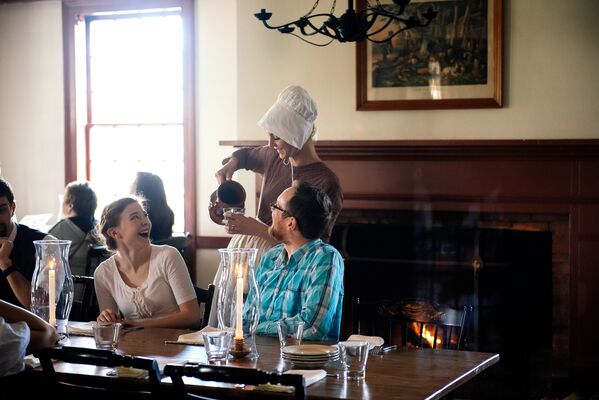
Photo by Emily Berger
“My absolute favorite thing about the tavern is the overall guest experience,” said Faraj. “There is simply no place like this anywhere in America where we are taking our guests on a journey to the past. Everything from our Calvin and Harriet Wood characters chatting with our guests to the food, to the look of the bill of fare and restaurant, and the servers in period clothing, we all collectively create an experience that is unique, historically accurate, and unmatched by any establishment.”
Faraj found inspiration for his menus from classic mid-1800s era cookbooks, like Mrs. Putnam’s Receipt Book and The Kentucky Housewife. It was in these wonderful books that he was inspired to create dishes such as our delicious Asparagus Soup, Pork and Potato Balls, and Bouilli Beef.
Eagle Tavern’s Asparagus Soup
serves many
Ingredients
- ½ pound unsalted butter
- 1 ½ cups yellow onion, medium dice
- 1 teaspoon fresh garlic, minced
- 5 pounds asparagus, trimmed
- 1 ½ cups celery, diced
- 2 bay leaves
- ¾ gallon vegetable broth
- ½ cup cornstarch
- 1 quart half-and-half
- Salt and pepper to taste
Method
- Heat a stockpot and melt the butter.
- Add the onions and garlic and cook over medium-high heat until onions are translucent.
- Add the asparagus, celery, bay leaves, and vegetable broth. Bring to a boil.
- Once boiling, turn heat to low and simmer until asparagus is tender.
- Add the cornstarch and half-and-half and puree the mixture with a hand blender until smooth. (You can also slowly break down the asparagus with a potato masher.)
- Add salt and pepper to your liking.
- Adjust the cornstarch if thicker or thinner soup is desired.
- Strain if you wish to have a lighter-style soup. Serve with fresh bread or crackers.
“The awesome curators here at The Henry Ford and I collaborate to find these menu items in cookbooks from the past,” said Faraj. “I then take said items and build the menu through both seasonal availability and the story of Harriet and Calvin Wood. It is not as simple as, ‘I found a recipe for a mid-1800s era style corn soup, so we are going to offer that soup.’”
Faraj and team take everything into consideration:
- How did season and local availability influence the meals that a tavernkeeper like Harriet Wood might have prepared for her tavern customers?
- What foodstuffs could have been imported in southern Michigan in 1850?
- What type of meals and desserts might Harriet Wood have had time to prepare over an open hearth in her busy tavern kitchen?
“In-depth research from period American cookbooks found in our research center, and expertise from our curators, help us find our way to these answers,” he said. “The ability to find a recipe from a book written almost two centuries ago, test that recipe, and then place it on a menu (that is seasonally accurate!) is what makes a chef working in historic dining challenging—yet fun!”
Eagle Tavern’s Pork and Potato Balls
serves many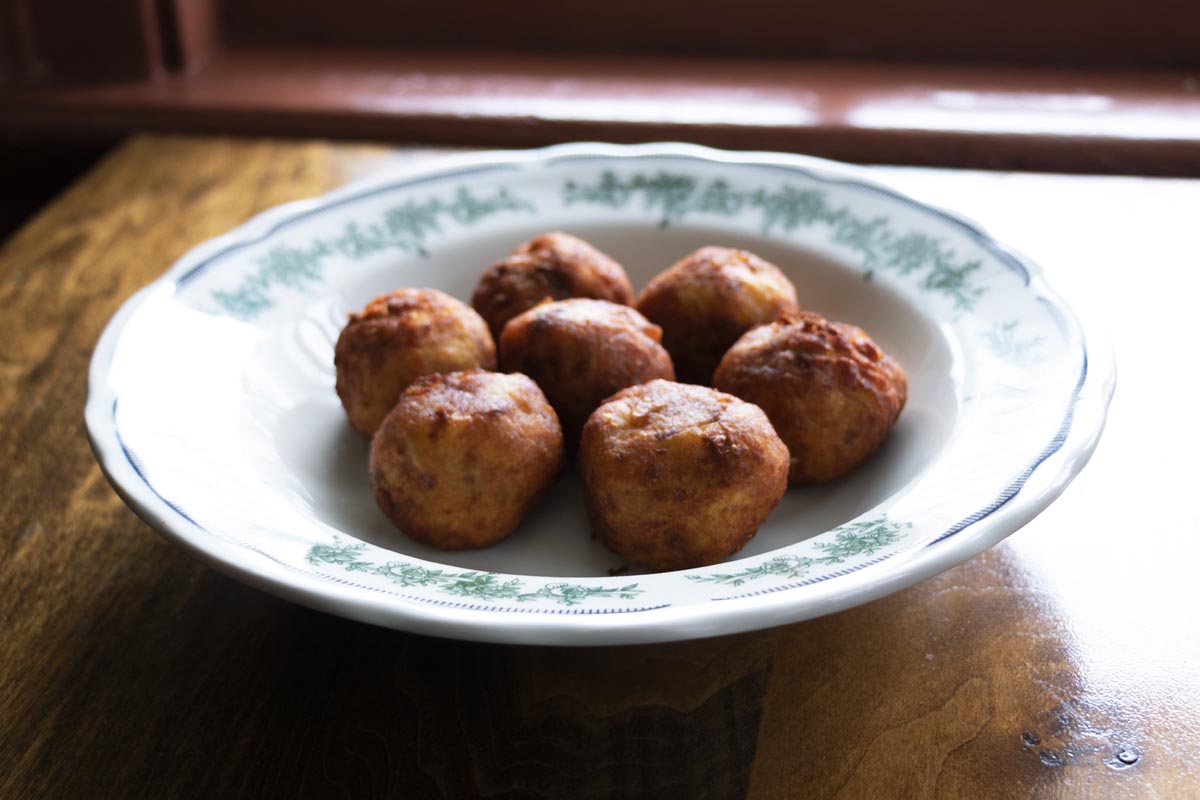
Ingredients
- 3 pounds cooked Idaho potatoes
- 3 fresh eggs
- 1 pound cooked pork-sage sausage, crumbled
- Salt and pepper to taste
- 1 pound unsalted butter
Method
- Put cooked potatoes in a large mixing bowl. Using a potato masher, mash the potatoes until there are very few lumps.
- In a separate bowl, whisk the eggs.
- Add the crumbled sausage, salt, and pepper to the eggs and mix until evenly distributed.
- Using a spoon or a small scooper, shape the mix into small balls no larger than a golf ball.
- Heat a nonstick pan and melt the butter.
- Cook the balls in the butter until browned on all sides and the internal temperature is 165° F. When cooked, sprinkle with additional salt and pepper and serve with extra butter, if desired.
One last recommendation from Chef Faraj: Eagle Tavern’s Bouilli Beef. “This dish is great served with roasted potatoes and mashed parsnips,” he said.
Eagle Tavern’s Bouilli Beef
serves many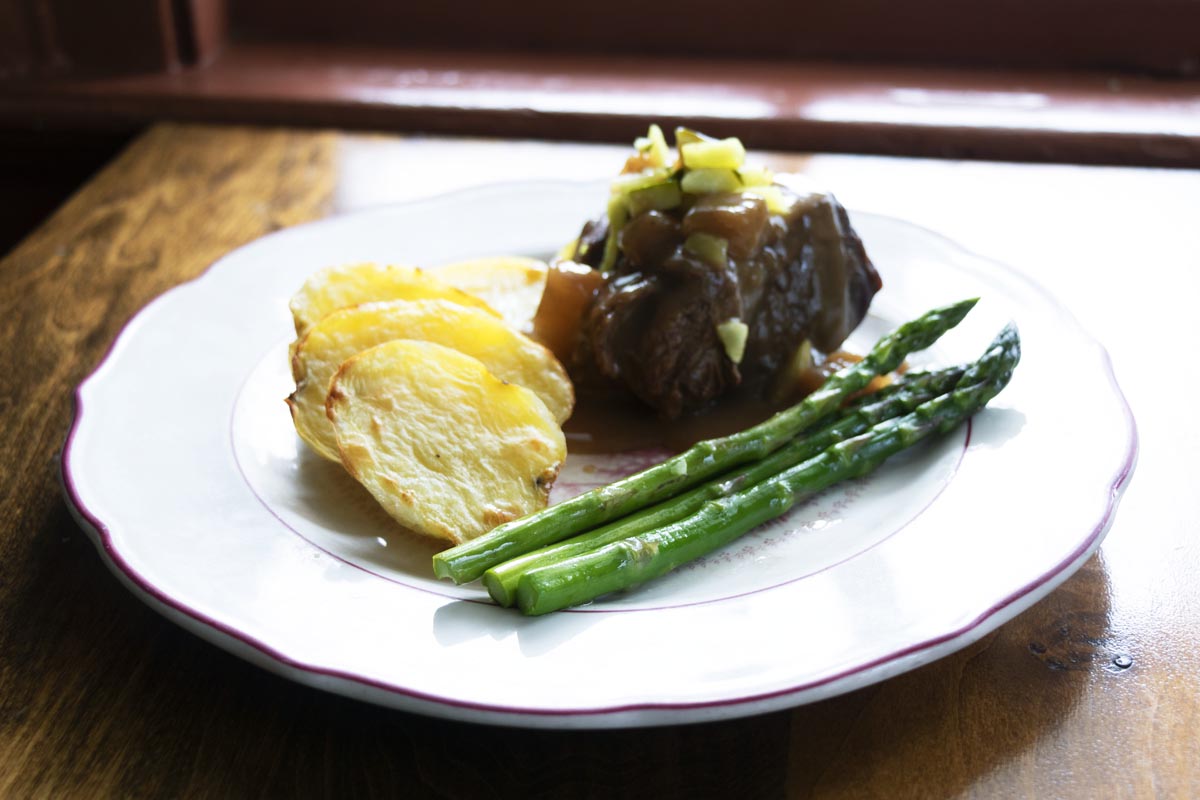
Ingredients
- 3 pounds beef, cut into 8-oz. portions (preferably chuck eye roll)
- Salt and pepper to taste
- 3 ounces vegetable oil
- 1 pound turnips, cut into 1-inch pieces
- ¼ pound yellow onion, medium dice
- ¼ pound peeled carrots, medium dice
- ¼ pound celery, medium dice
- 1 ½ gallons beef stock
- 2 bay leaves
- ½ teaspoon ground cloves
- 6 cloves fresh garlic
- 1 ounce soy sauce
- 2 ounces Dijon mustard
- 4 ounces cornstarch
- 4 ounces chopped sweet pickles
Method
- Season the beef with salt and pepper. Heat the vegetable oil in a stockpot on the stove and sear the meat on all sides.
- Add the rest of the ingredients except for the soy sauce, mustard, cornstarch, and pickles.
- Bring it all to a boil; once boiling, turn the heat down to a low setting and cover. Let cook slowly until the meat is almost fall-apart tender, 2-3 hours. Turn off and leave on stove.
- Take half the stock the beef was cooked in and strain. Whisk together the soy sauce, mustard, and strained stock in a small saucepot over medium heat. Add the cornstarch and bring to a slow boil; cook until gravy is slightly thick. Add the cooked beef and plate with the turnips it was cooked with.
- Ladle 2-3 ounces of gravy over each piece and top with chopped pickles.
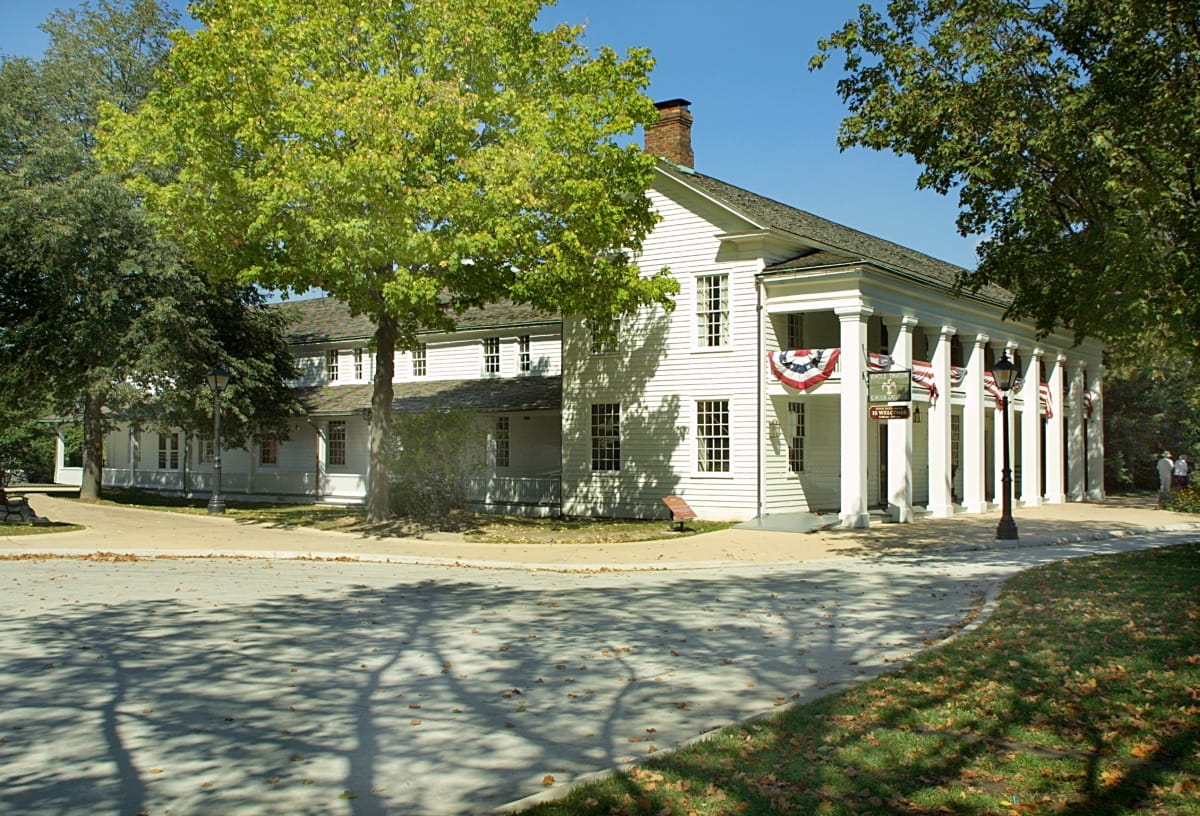
Eagle Tavern, Greenfield Village / THF1918
Want to learn more about Eagle Tavern? Look below for links to blog posts, Innovation Nation segments, and artifact records.
All About Eagle Tavern
- Artifact Record: Eagle Tavern
- Plan Your Visit
- Creating the Eagle Tavern Dining Experience
- The Henry Ford’s Innovation Nation: 1850s Dining Experience at Eagle Tavern
- 1988 Eagle Tavern Cookbook
Drink Recipes
Dig Deeper
- Greenfield Village Building Makeovers
- Meet Calvin Wood
- Drinking at Eagle Tavern
- Root Vegetables, Now & Then
- Behind the Bar at Eagle Tavern
Lish Dorset is Marketing Manager, Non-Admission Products, at The Henry Ford.
making, Michigan, recipes, food, restaurants, by Lish Dorset, Greenfield Village buildings, Greenfield Village, Eagle Tavern
Celebrating Lamy’s Diner
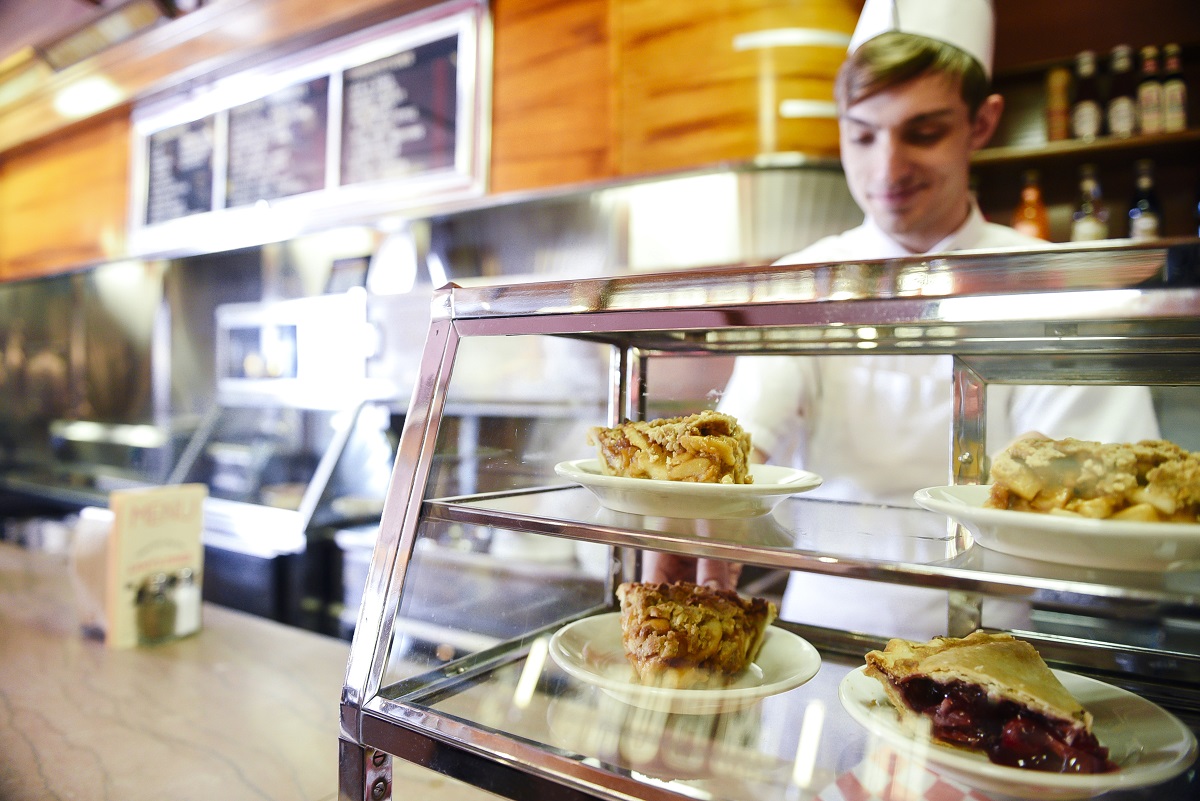 Photo by Emily Berger
Photo by Emily Berger
This month we are excited to reopen a guest favorite inside Henry Ford Museum of American Innovation: Lamy's Diner, a must-stop destination closed for almost two years during the COVID-19 pandemic. Operating as a restaurant inside the museum since 2012, Lamy’s provides members and guests an authentic 1940s diner experience, complete with chicken salad sandwiches and frappes. (And Toll House chocolate chip cookies, of course!)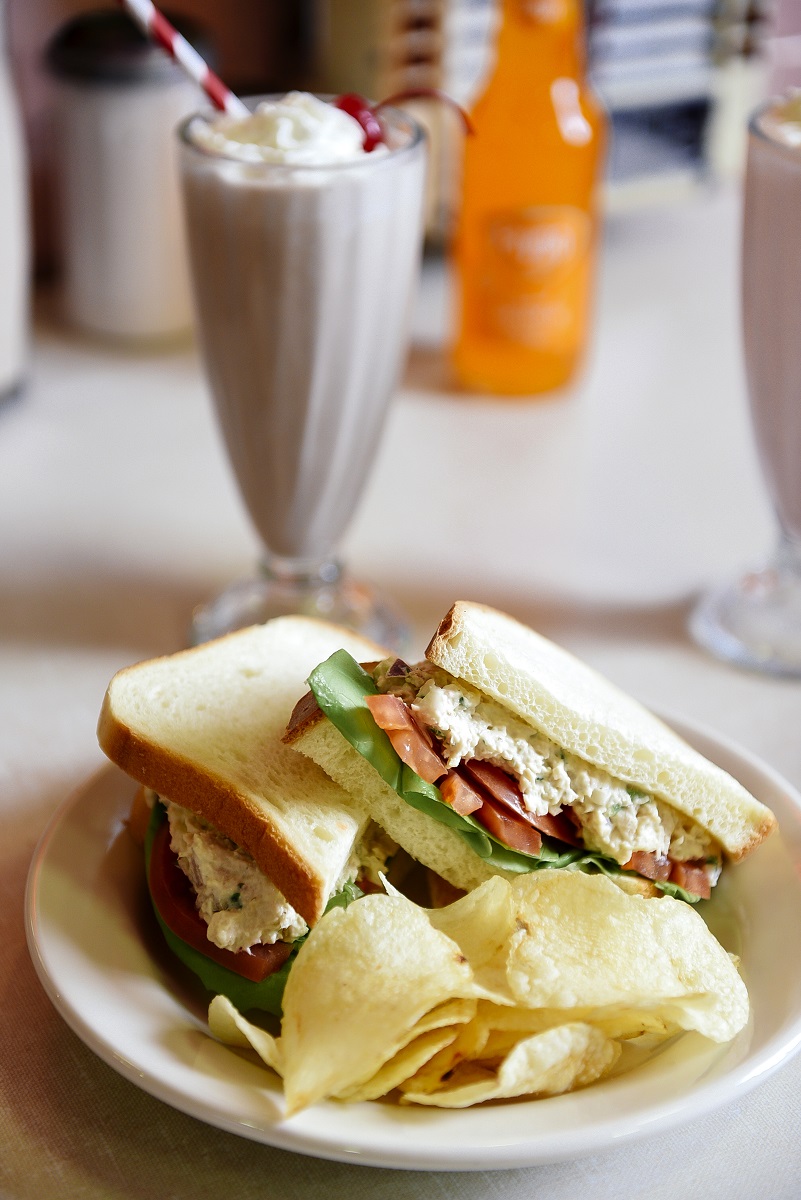
Photo by Emily Berger
In honor of Lamy’s reopening for daily dining, Eric Schilbe, Executive Sous Chef at The Henry Ford, shares two recipes that are crowd pleasers on the menu: tomato soup (an occasional special) and maple chicken salad. Try making these favorites at home, and then dig deeper into all-things Lamy’s in our Digital Collections.
Recipes
Lamy’s Tomato Soup
Makes about 4-5 bowls
Why we use this recipe:This is a very traditional tomato soup that has plenty of vegetable flavor and a touch of richness from the Parmesan cheese. (Psst! Don’t add the cheese until the very end!)
Ingredients
- 2T olive oil
- 1 large onion, diced
- 4 stalks small diced celery
- 2 carrots, chopped
- 1 bay leaf
- 1t dried basil
- 2 large cans diced tomato (plain – no seasoning)
- 1 cup half-and-half
- 1t pepper
- ¼ cup Parmesan cheese
Directions
- Cook the onions, carrots, and celery with oil in a stainless pot until completely tender.
- Add tomatoes, bay leaf, basil, and simmer about 30-40 minutes until completely cooked. (It should be a little darker than when you started.)
- Finish with half and half, Parmesan cheese, and pepper. Remove from heat.
- Using a blender, blend the soup until very smooth, and then serve immediately.
Chef’s Notes
- All canned tomatoes are not created equal! You may need to adjust with a little water or cook them down longer.
- Cook your vegetables until they are completely tender and falling apart—this will add richness to the flavor.
Lamy’s Maple Chicken Salad
Makes about 4-5 sandwiches
Why we use this recipe: Chicken salad can be such a simple recipe, but by adding maple syrup, a classic New England ingredient, and a touch of cumin, we set it apart from others.
Ingredients
- 2 large chicken breasts, cooked and cooled
- 4 stalks small diced celery
- ¼ minced red onion
- 1T yellow mustard
- 1T pure maple syrup
- ¼ cup mayonnaise
- 2T sour cream
- 1/4t cumin
- 1T fresh parsley, chopped fine
- 1t pepper
Directions
- Cook, cool, and pick the chicken. Place in a food processor and pulse until shredded fine.
- Add all other ingredients together and mix well.
- Let set, refrigerated, for 1-2 hours before serving.
Chef’s Notes
- During this era, the chicken was typically shredded very fine and simple ingredients were used. When making this at home, make sure the chicken is not overcooked and that it is very well shredded. This will make the salad moist and flavorful; you can always add a touch more mayonnaise.
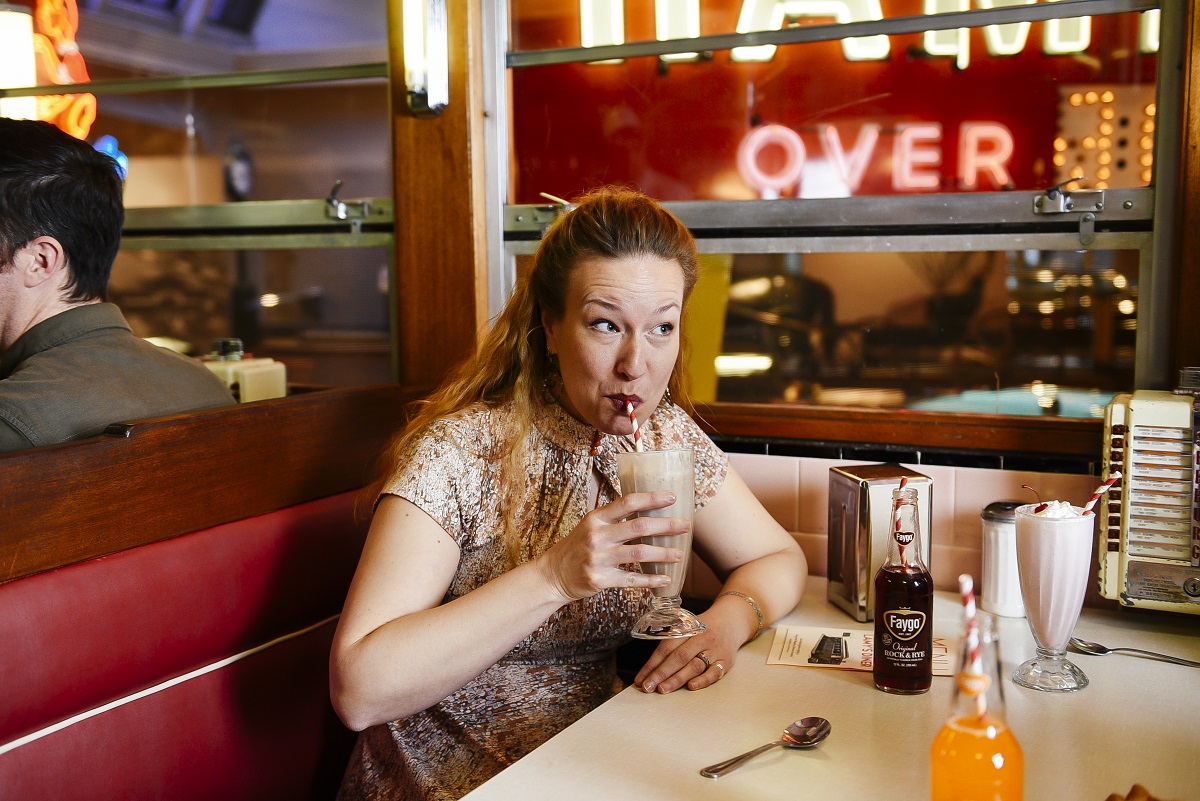
Photo by Emily Berger
Dig Deeper: Lamy's Online
All About Lamy’s
- Plan Your Visit: Lamy’s Diner (find notes on visiting and hours)
- Lamy’s Diner, 1946 (check out the Lamy’s artifact page in our Digital Collections)
- Lamy’s: A Diner from the Golden Age (explore the history of Lamy’s on our blog)
- Lamy’s Gets a Makeover (2017) (learn about our 2017 updates to Lamy’s menu; note that additional changes have been made since)
- Lamy’s on TV: Mr. Coffee – The Henry Ford’s Innovation Nation
Diners, Drive-Ins... and Cookies
- Diners: An American Original (dig into the history of the diner on our blog)
- Dig Deeper: Owl Night Lunch Wagon (explore artifacts related to Greenfield Village’s own Owl Night Lunch Wagon)
- Inventing America’s Favorite Cookie (find out how America’s favorite cookie, the Toll House chocolate chip cookie, was born)
- Flipping Burgers into a Career (learn the story of Don Dunivent, who worked for White Castle from the 1920s through the 1950s)
- Dig Deeper: Lunch Wagons (check out artifacts related to lunch wagons in our Digital Collections)
More Historic Dining at The Henry Ford
- Creating the Eagle Tavern Dining Experience (go behind-the-scenes to learn how we developed the menu for Greenfield Village’s Eagle Tavern)
- Beyond the Peanut: Food Inspired by Carver (discover how agricultural scientist George Washington Carver’s own recipes provided inspiration for some of our recipes at A Taste of History and Plum Market Kitchen)
Lish Dorset is Marketing Manager, Non-Admission Products, and Eric Schilbe is Executive Sous Chef at The Henry Ford.
Additional Readings:
- Lamy's Diner
- Lamy's: A Diner from the Golden Age
- Lamy's Diner at Its Original Site in Marlborough, Massachusetts, circa 1946
- Diners: An American Original
COVID 19 impact, recipes, by Eric Schilbe, by Lish Dorset, food, Driving America, Henry Ford Museum, diners, restaurants
Collecting Mobility: Insights from General Motors
Our new limited-engagement exhibit, Collecting Mobility: New Objects, New Stories, opening to the public October 23, 2021, takes you behind the scenes at The Henry Ford to show you how we continue to grow our vast collection of more than 26 million artifacts. One key question the exhibit asks is why we collect the items we collect. To get more insight on the artifacts on exhibit and future trends that may impact our collecting, we reached out to several of our partners. In this post from that series, our friends at General Motors (GM), donors of the General Motors first-generation self-driving test vehicle in the exhibit and contributors to our Driven to Win: Racing in America exhibit, tackle questions about autonomous vehicles (AVs), electric vehicles (EVs), and racing.
Our latest permanent exhibit, Driven to Win: Racing in America, is presented by General Motors. How has GM’s racing program evolved over time?
GM’s Chevrolet and Cadillac brands have both had long, storied histories in motorsports. Racing is a fundamental part of what we do—from transferring technology learned on the track to help us build better vehicles to connecting with consumers through something they love.
Racing driver Louis Chevrolet co-founded GM’s Chevrolet brand with William C. Durant in 1911. / THF277330
Chevrolet has been successful in professional motorsports in the United States and around the globe, capturing many manufacturer, driver, and team championships in NASCAR, IndyCar, IMSA, and the NHRA. From stock cars to advanced prototypes, Cadillac Racing has a rich history—more than half a century—of racing around the world and around the clock on some of the world’s notably challenging circuits.
Off the track, our racing programs have evolved with the help of our GM facilities. In 2016, General Motors opened the doors to the all-new GM Powertrain Performance and Racing Center—a state-of-the-art facility designed to enhance the development processes for the company’s diverse racing engine programs.
In 2021, General Motors broke ground on the new Charlotte Technical Center, a 130,000-square-foot facility that will expand GM’s performance and racing capabilities. The facility is a $45 million investment for GM and it will be a strong hub for the racing and production engineering teams to collaborate, share resources, and learn together, delivering better results more quickly, both on the racetrack and in our production vehicles.
The Chevrolet Corvette has a long, proud history in professional and amateur sports car racing. This pair of Corvettes is seen at a Sports Car Club of America race in Maryland in 1959. / THF135778
Engineering has become incredibly advanced over time, and leveraging tools between racing and production has become extremely important. We use tools like computational fluid dynamic models, which uses applied mathematics, physics, and computational software to visualize how a gas or liquid flows. These CFD models help us predict things like powertrain performance and aerodynamics.
Also, our Driver-in-the-Loop simulator allows us to test vehicles on courses virtually. It is the combination of two technologies: a real-time computer (with vehicle hardware) and a driving simulator. The driving simulator allows our development engineers to drive and test the real-time computer simulation and added hardware system on a virtual track, just like they would a physical prototype. The simulator was used extensively during the development of the mid-engine Corvette C8.R race car.
The 2001 C5-R Corvette is currently on loan from General Motors and can be seen by guests inside Driven to Win: Racing in America. Why was this vehicle selected to go on display inside Henry Ford Museum of American Innovation?
The Corvette C5-R made its debut in 1999 at the Rolex 24 at Daytona and was a fixture of global GT racing for the next five years. From 1999–2004, Corvette Racing and the C5-R set the standard for racing success with 31 victories in the American Le Mans Series, along with an overall victory at the Rolex 24 in 2001.
During six years of competition, Corvette Racing—the first factory-backed Corvette team in the car’s history—led the C5.R to an overall victory at the Daytona 24-hour race and three 1-2 finishes in the GTS class at the 24 Hours of Le Mans. During the 2004 season, Corvette Racing won every race the team entered and captured every pole position in the American Le Mans Series.
2001 C5-R Corvette, on loan from General Motors Heritage Center and currently on exhibit in Driven to Win: Racing in America in Henry Ford Museum of American Innovation. / THF185966
This specific car raced 17 times from August 2000 through June 2002 with 10 wins. It brought home the first win for the factory Corvette Racing program—Texas 2000 in the ALMS’ GTS class. Then it went on to become 2001 overall winner at Rolex 24, which was quite an accomplishment for a GT car. The car went on to win its class at Le Mans 24 in both 2001 and 2002. The modern era of Corvette’s factory racing program continues today, after over 20 years and 4 generations (C5/C6/C7/C8).
The success of this C5-R essentially started it all and we are proud to have it on display.
General Motors' donation of the 2016 GM First-Generation Self-Driving Test Vehicle was our first self-driving car acquisition. Why was it important to have this car join more than 300 others—including GM landmarks like the 1927 LaSalle and the 1997 EV1 Electric—in the collections of The Henry Ford?
This vehicle represents a huge step forward on the journey to fully autonomous driving. With Cruise, our majority-owned subsidiary, we’re determined to commercialize safe, autonomous, and electric vehicles on our way to a driverless future—one with zero crashes.
General Motors tested a series of autonomous vehicles in San Francisco, California, and Scottsdale, Arizona, in 2016. These cars used a combination of cameras, radar and lidar sensors, cellular and GPS antennas, and powerful computers to drive themselves on public streets in both cities. GM donated this one, now on exhibit in Driving America in Henry Ford Museum of American Innovation, to The Henry Ford in 2018. / THF173551
Cruise was the first AV company permitted to give rides to the public in its current driverless vehicles in the San Francisco area. Expansion of our real-world test fleet will help ensure that our self-driving vehicles meet the same strict standards for safety and quality that we build into all of our vehicles.
GM became the first company to assemble self-driving test vehicles in a mass-production facility when its next generation of self-driving Chevrolet Bolt EV test vehicles began rolling off of the line at Orion Township, Michigan, in January 2017.
The self-driving Chevrolet Bolt EVs feature an array of equipment, including LIDAR, cameras, sensors, and other hardware designed to accelerate development of a safe and reliable fully autonomous vehicle.
Reshaping cities and the lives of those who live in them has tremendous societal implications. Since we believe that all AVs will be EVs, these efforts will clearly advance our vision of zero crashes, zero emissions, and zero congestion, and help us build a more sustainable and accessible world.
This vehicle was really the first of its kind and its display is a sneak peek at the future of autonomy.
By 2025, General Motors plans to offer more than 30 electric vehicles globally. What does an all-electric future look like for Generation E?
For electric vehicles to make an impact, we need consumers to embrace them in mass numbers. So earlier this year, General Motors introduced the world to EVerybody In.
This is our brand commitment toward advancing a world with zero crashes, zero emissions, and zero congestion. EVerybody In is more than a brand campaign, it's a global call to action for everybody to join us on the road to an all-electric future.
GM introduced the EV1 in 1997. It was among the most sophisticated electric cars built during the 20th century. / THF91060
GM wants to put everyone in an EV. Thanks to Ultium, our EV architecture, GM is able to reimagine the vehicles it produces today as electric vehicles with equivalent power, excellent range, and a manufacturing cost different that is expected to diminish as EV production increases.
Not only will our EVs be fun to drive and cost less to own, they will also provide an outstanding customer experience. This is how we will encourage and inspire mass consumer adoption of EVs. GM has the technology, talent, scale, and manufacturing expertise to do it.
The all-electric future we are creating goes beyond our vehicles, it is inspiring us to do even more to help mitigate the effects of climate change. We plan to source 100 percent renewable energy to power our U.S. sites by 2025, and to become carbon neutral in our global vehicles and operations by 2040.
General Motors wants to impact society in a positive way and these are some of the steps we are taking to make it happen.
General Motors is committed to electrification—what types of current EV projects from the company might we expect to see in the museums of tomorrow?
With more than 30 EVs being introduced by 2025, we have a lot of exciting vehicles coming. From sedans, to trucks, to full-size SUVs, we will have a wide range of offerings in terms of size and design.
We are entering an inflection point in the transportation industry, a transformation the industry has not seen in decades—the mass adoption of electric vehicles. The first of any of these entries will be a sight to see in the museums of tomorrow for generations to come.
Lish Dorset is Marketing Manager, Non-Admission Products, at The Henry Ford. Todd Christensen is Strategy and Operations Manager, Chevrolet Motorsports Marketing & Activation, and Gina Peera is Corporate Strategy and Executive Communications at General Motors. General Motors is a global automotive manufacturer, driving the world forward with the goal to deliver world-class customer experiences at every touchpoint and doing so on a foundation of trust and transparency. See Collecting Mobility for yourself in Henry Ford Museum of American Innovation from October 23, 2021, through January 2, 2022.
Additional Readings:
- Driven to Win: Sports Car Performance Center
- A Lesson in Safety: Salt Walther’s Race Car
- I Would Drive 500 Miles: Scottish Drivers at the Indy 500
- 2001 Chevrolet Corvette C5-R. On Loan from General Motors Heritage Center.
engineering, manufacturing, Henry Ford Museum, Driving America, Chevrolet, alternative fuel vehicles, technology, autonomous technology, Driven to Win, race cars, racing, cars, by Gina Peera, by Todd Christensen, by Lish Dorset
Sallie Lunn Bread Recipe

For those who brought home our stoneware bread cloche (a versatile baking piece created by our artisans in Greenfield Village, which allows you to mix your dough, proof it, then bake it, all in one dish) during the holiday season last year, you know that the resulting bread is light and airy with a golden crust.
If you’re wondering what our go-to recipe is for this 1800s-inspired baking piece, it’s Sallie Lunn Bread. Made regularly inside the kitchen at Firestone Farmhouse and acting as the inspiration for recipes inside A Taste of History, this recipe is credited to Farmer’s and Housekeeper’s Cyclopaedia, Stephen Lewandowski, Ed., 1888, p. 326.
Sallie Lunn Bread
- 1quart (4 cups) of flour
- 4 eggs
- 1 pint (2 cups) of milk
- 1 tablespoonful of lard
- 1 tablespoonful of butter
- 2 spoonsful of sugar
- 1 gill of yeast
Pre-heat the oven to 350 degrees. When baking inside of our stoneware bread cloche, bake for 40 to 45 minutes, until the top is golden-brown and the loaf has a hollow sound when tapped.
Lish Dorset is Marketing Manager, Non-Admission Products, at The Henry Ford.
Celebrating All Things Bicycle

In 1902, the U. S. adopted Rural Free Delivery. Americans in the countryside would no longer need to go to town to get their mail -- the mail would be brought to them. Rural letter carrier, Orville J. Murphy, pictured here circa 1905, used a bike to deliver mail to outlying households around New London, Iowa. THF 201311
Since 1956, May has held the honor of being designated as National Bike Month. The holiday celebrates cyclists of all kinds across the United States and encourages everyone to get outside and hit the road on two wheels. Within the month of May one week is all about biking to work. This year National Bike to Work Week is May 16-20 and today, May 20, is Bike to Work Day.

Here at The Henry Ford, bicycles are a big part of our staff members' work day, from our employees arriving by bike to our campus in the morning to using antique bikes to travel around Greenfield Village during the day as part of their daily routines. Online, our digital collections offer hundreds of artifacts all related to bicycles, from photos of bicycle races to a shot of Walt Disney trying out a high-wheel safety bicycle inside Henry Ford Museum in the 1940s, shown above, to this 1869 miniature bicycle used by Tom Thumb.
Continue Reading
A Vaudeville Hallowe'en

New to Hallowe’en in Greenfield Village this year is the Top Hat Side Show. Led by Andrew D'Ascenzo, a professional circus and fire performer, the vaudeville-style show features unique acts in several fields including circus, fire, sideshow, magic, and comedy. Vaudeville performances aren’t new to The Henry Ford; every summer in Greenfield Village our dramatic programs in Town Hall combine music, comedy, and dance revues that pay homage to the great music and zany humor found in vaudeville. Continue Reading
holidays, Hallowe'en in Greenfield Village, Halloween, Greenfield Village, events, by Lish Dorset
Celebrating Manufacturing

Today organizations across the country are honoring manufacturing with Manufacturing Day, a day celebrating modern manufacturing. There are more than 2,000 events to choose from. We tell the story of manufacturing through our Ford Rouge Factory Tour experience and the artifacts within our collections. If you're curious to learn more about Henry Ford and manufacturing, take a look at this collection of blog posts and videos.
- Ford's Five-Dollar Day
- Activating Today's Maker Community
- #1 Cars at The Henry Ford
- A Technical Look at the 2015 North American International Auto Show
- Ford Methods and the Ford Shops
Lish Dorset is Social Media Manager at The Henry Ford.
Morgantown Personal Rapid Transit

Yesterday Atlas Obscura shared a post about the Morgantown Personal Rapid Transit (PRT) and it caught Brian Wilson's, our Digital Access & Preservation Archivist, eye. Brian took a look at our archives and found slides from our Sundberg-Ferar Collection. (You might remember this collection from a post Brian wrote about sketches for a manned space station in the 1980s.) Sundberg-Ferar worked on a number of public transit and rapid transit projects, and our collection contains material dating from the 1960s into the 1980s. Among those projects are the BART system in San Francisco, and the Morgantown, West Virginia, transit system which is illustrated by these four images. Different exterior and interior design concepts are shown, along with a scale model of a vehicle between two station platforms. You can see a portion of those concept drawings there in the background of the scale model photo.



This isn’t Brian’s first detective-like hunt through our archives. Last fall he found out why Edsel Ford’s 1934 Detroit Lions season pass was cancelled after a questions was asked about it on Twitter.
Lish Dorset is Social Media Manager at The Henry Ford.

While our annual Motor Muster weekend takes us back to an era of classic cruisers, this year's Saturday night Record Hop USA! dance party is focusing on one particular year and a moment in music history: 1964 and the arrival of the Beatles in America.

While we celebrated the 50th anniversary of the British Invasion in 2014, the recent induction of Ringo Starr into the Rock and Roll Hall of Fame and Paul McCartney hitting the road for the summer festival circuit remind us that we don't need an official anniversary to honor The Fab Four whenever we want.

This Saturday you can join us for a night of dancing and and favorite 1960s hits in Greenfield Village during Motor Muster. For those who can't join us for dance lessons on Main Street, you can learn more about 1964 and the Beatles' first trip to America thanks to our collections and this blog post from Curator of Public Life Donna Braden.
Lish Dorset is Social Media Manager at The Henry Ford.Additional Readings:
- Motor Muster
- The Henry Ford Plans for Motor Muster to Return to Greenfield Village Father’s Day Weekend, June 19-20
popular culture, by Lish Dorset, music, Greenfield Village, car shows, cars, Motor Muster, events

